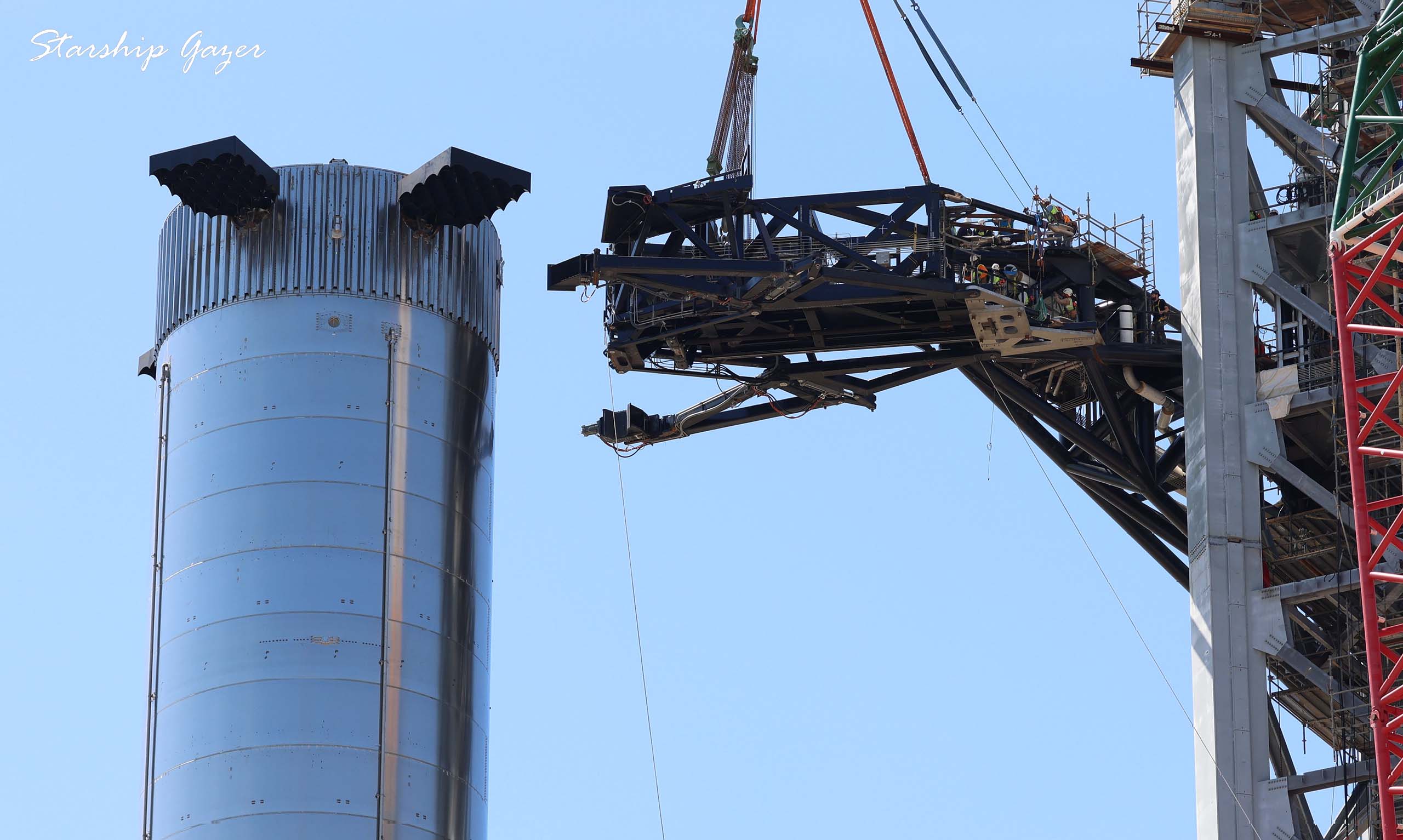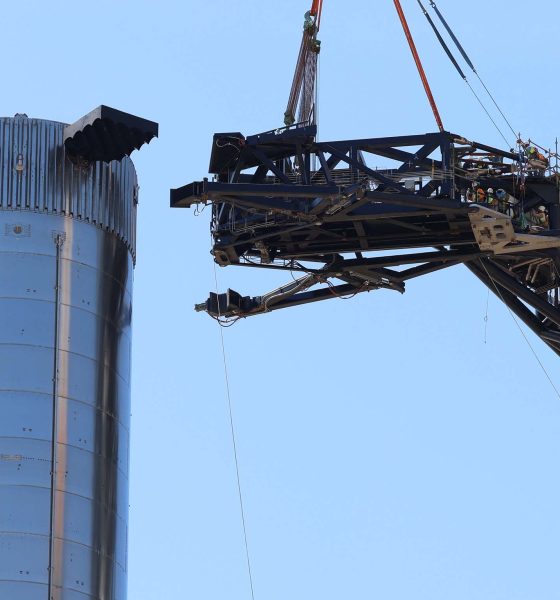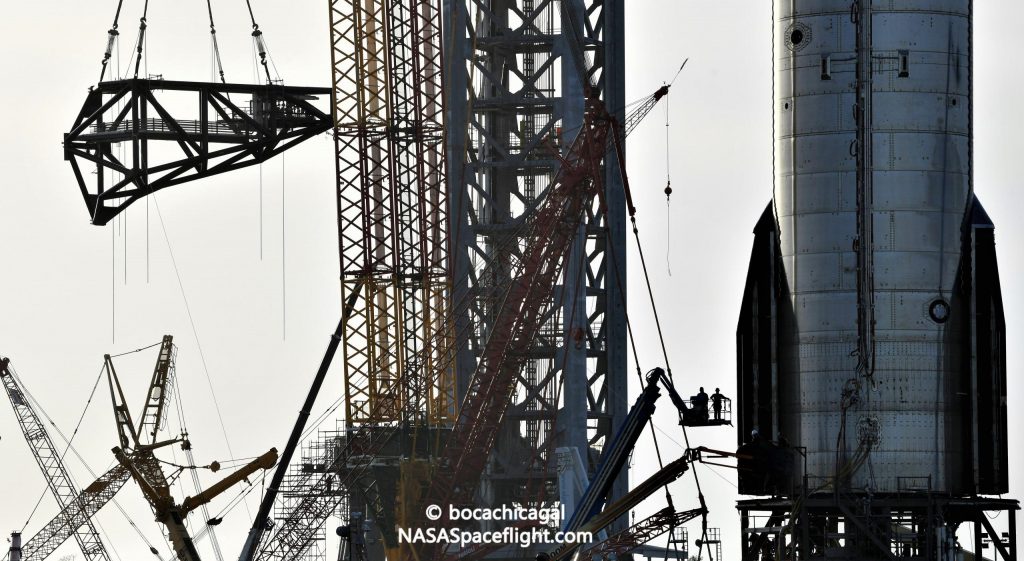

News
SpaceX installs Mechazilla ‘claw’ on Starship launch tower
In the latest chapter of SpaceX’s Starship launch tower chronicle, the company has rolled a claw-like component to the pad and attached the device to the end of the tower’s newly installed Starship ‘quick disconnect’ arm.
A couple months ago, as SpaceX’s newest Starship prototype and first orbital-class vehicle first started to come together, it became clear that the company was implementing a significant design change starting with Ship 20 (S20). Contrary to five years of official Starship/BFR/ITS updates in which the ship (second stage) was expected to connect to pad ground systems (power, propellant, gases, communications) through the booster (first stage), Starship S20’s umbilical panel was instead conspicuously installed on the exterior of the ship’s hull.
Later on, in an interview and tweets, it became clear that the move away from longstanding ship-to-booster umbilical plans was part of CEO Elon Musk’s latest crusade: moving parts and complexity from Starship and Super Heavy to the launch pad at any cost. As a result, rather than adding a little extra weight to Super Heavy and likely reducing total payload to orbit by a percent or two for an extremely simple, protecting umbilical solution, SpaceX would instead have to implement a massive swinging arm that would reach out from Starship’s launch tower to connect it to pad systems.
While it’s hard to say if that decision and the major design changes it’s entailed will prove to be the right move, what is undeniable is how rapidly SpaceX turned on a dime to build and install the extremely complex mechanisms required. Assembly of what has come to be known as Starship’s tower quick-disconnect (QD) arm really only began in early July. Less than two months later, the finished base of that arm was lifted around halfway up the ~145m (~475 ft) tall launch tower and affixed to two sturdy hinges.

Three weeks later, a new and initially mysterious structure SpaceX began assembling around August 20th has also been finished and installed at the end of the QD arm – adding an actuating tip and apparent stabilization ‘claw’ to the already massive swinging structure. Aside from a bit of plumbing and wiring, the only thing that arm now appears to be missing is the actual quick-disconnect umbilical panel that will allow it to temporarily connect to Starships to deliver power, propellant, and connectivity.
That quick-disconnect mechanism will likely sit directly on top of the brand new claw and stand several meters tall to span the gap between the top of Super Heavy and Starship’s umbilical panel. Two large, actuating arms at the bottom of the arm’s tip will be able to grab Super Heavy, stabilizing the massive booster during Starship installation. Once firmly installed on top of the booster, the claw’s missing quick-disconnect mechanism will then move in to connect to Starship.
Of course, the quick disconnect arm is just one of – and the most minor of – three massive ‘Mechazilla’ arms destined for the launch tower. Just a few hundred feet to the west, SpaceX is hard at work fabricating and assembling two far larger tower ‘catch’ arms and the cradle-like frame they’ll eventually attach to. While they will also give SpaceX far more flexibility to stack and manipulate Super Heavy and Starship in high winds and less than optimal weather conditions, the ultimate purpose of those arms is to catch Super Heavy boosters (and, maybe one day, Starships). According to a new contributor to NASASpaceflight forums, those Mechazilla catch arms could be installed as early as “this weekend or next week.”

Elon Musk
Tesla’s Elon Musk gives timeframe for FSD’s release in UAE
Provided that Musk’s timeframe proves accurate, FSD would be able to start saturating the Middle East, starting with the UAE, next year.

Tesla CEO Elon Musk stated on Monday that Full Self-Driving (Supervised) could launch in the United Arab Emirates (UAE) as soon as January 2026.
Provided that Musk’s timeframe proves accurate, FSD would be able to start saturating the Middle East, starting with the UAE, next year.
Musk’s estimate
In a post on X, UAE-based political analyst Ahmed Sharif Al Amiri asked Musk when FSD would arrive in the country, quoting an earlier post where the CEO encouraged users to try out FSD for themselves. Musk responded directly to the analyst’s inquiry.
“Hopefully, next month,” Musk wrote. The exchange attracted a lot of attention, with numerous X users sharing their excitement at the idea of FSD being brought to a new country. FSD (Supervised), after all, would likely allow hands-off highway driving, urban navigation, and parking under driver oversight in traffic-heavy cities such as Dubai and Abu Dhabi.
Musk’s comments about FSD’s arrival in the UAE were posted following his visit to the Middle Eastern country. Over the weekend, images were shared online of Musk meeting with UAE Defense Minister, Deputy Prime Minister, and Dubai Crown Prince HH Sheikh Hamdan bin Mohammed. Musk also posted a supportive message about the country, posting “UAE rocks!” on X.
FSD recognition
FSD has been getting quite a lot of support from foreign media outlets. FSD (Supervised) earned high marks from Germany’s largest car magazine, Auto Bild, during a test in Berlin’s challenging urban environment. The demonstration highlighted the system’s ability to handle dense traffic, construction sites, pedestrian crossings, and narrow streets with smooth, confident decision-making.
Journalist Robin Hornig was particularly struck by FSD’s superior perception and tireless attention, stating: “Tesla FSD Supervised sees more than I do. It doesn’t get distracted and never gets tired. I like to think I’m a good driver, but I can’t match this system’s all-around vision. It’s at its best when both work together: my experience and the Tesla’s constant attention.” Only one intervention was needed when the system misread a route, showcasing its maturity while relying on vision-only sensors and over-the-air learning.
News
Tesla quietly flexes FSD’s reliability amid Waymo blackout in San Francisco
“Tesla Robotaxis were unaffected by the SF power outage,” Musk wrote in his post.

Tesla highlighted its Full Self-Driving (Supervised) system’s robustness this week by sharing dashcam footage of a vehicle in FSD navigating pitch-black San Francisco streets during the city’s widespread power outage.
While Waymo’s robotaxis stalled and caused traffic jams, Tesla’s vision-only approach kept operating seamlessly without remote intervention. Elon Musk amplified the clip, highlighting the contrast between the two systems.
Tesla FSD handles total darkness
The @Tesla_AI account posted a video from a Model Y operating on FSD during San Francisco’s blackout. As could be seen in the video, streetlights, traffic signals, and surrounding illumination were completely out, but the vehicle drove confidently and cautiously, just like a proficient human driver.
Musk reposted the clip, adding context to reports of Waymo vehicles struggling in the same conditions. “Tesla Robotaxis were unaffected by the SF power outage,” Musk wrote in his post.
Musk and the Tesla AI team’s posts highlight the idea that FSD operates a lot like any experienced human driver. Since the system does not rely on a variety of sensors and a complicated symphony of factors, vehicles could technically navigate challenging circumstances as they emerge. This definitely seemed to be the case in San Francisco.
Waymo’s blackout struggles
Waymo faced scrutiny after multiple self-driving Jaguar I-PACE taxis stopped functioning during the blackout, blocking lanes, causing traffic jams, and requiring manual retrieval. Videos shared during the power outage showed fleets of Waymo vehicles just stopping in the middle of the road, seemingly confused about what to do when the lights go out.
In a comment, Waymo stated that its vehicles treat nonfunctional signals as four-way stops, but “the sheer scale of the outage led to instances where vehicles remained stationary longer than usual to confirm the state of the affected intersections. This contributed to traffic friction during the height of the congestion.”
A company spokesperson also shared some thoughts about the incidents. “Yesterday’s power outage was a widespread event that caused gridlock across San Francisco, with non-functioning traffic signals and transit disruptions. While the failure of the utility infrastructure was significant, we are committed to ensuring our technology adjusts to traffic flow during such events,” the Waymo spokesperson stated, adding that it is “focused on rapidly integrating the lessons learned from this event, and are committed to earning and maintaining the trust of the communities we serve every day.”
News
Waymo scrutinized after self-driving taxis cause traffic jams during SF blackout
It’s not farfetched to speculate that it would have been a doomsday scenario for Tesla had FSD behaved this way.

A power outage across San Francisco over the weekend forced numerous Waymo self-driving taxis to stop at darkened intersections and cause traffic blockages in multiple locations across the city. The disruption left riders stranded, frustrated drivers blocked, and city officials stepping in as the Alphabet-owned company temporarily suspended service amid the widespread gridlock.
Needless to say, it would likely have been a doomsday scenario for Tesla had FSD behaved in a similar way, especially if fleets of its robotaxis blocked traffic for numerous drivers.
Power outage halts Waymo fleet
The outage knocked out electricity for tens of thousands of customers, leaving traffic signals dark across large parts of the city, as noted in a report from the New York Times. Waymo vehicles began stopping at intersections and remained stationary for extended periods, seemingly unable to operate. Tow truck operators worked through the night removing immobilized vehicles, while videos circulated online showing Waymos with hazard lights flashing as traffic backed up around them.
Waymo later confirmed that it had paused its Bay Area ride-hailing service after the San Francisco mayor’s office contacted the company about the congestion its vehicles were contributing to. Service began coming back online shortly after 3:30 p.m. local time, though some users still reported being unable to request rides. Waymo maintained that no injuries or accidents were reported during the outage.
Autonomous cars during emergencies
The incident surprised industry observers since autonomous vehicles are designed to function during signal outages and temporary connectivity losses. Waymo stated that its vehicles treat nonfunctional signals as four-way stops, but “the sheer scale of the outage led to instances where vehicles remained stationary longer than usual to confirm the state of the affected intersections. This contributed to traffic friction during the height of the congestion.” Experts suggested the problem may have been linked to the vehicles’ reliance on remote assistance teams, which help resolve complex situations the cars cannot handle independently.
“Yesterday’s power outage was a widespread event that caused gridlock across San Francisco, with non-functioning traffic signals and transit disruptions. While the failure of the utility infrastructure was significant, we are committed to ensuring our technology adjusts to traffic flow during such events,” the Waymo spokesperson stated, adding that it is “focused on rapidly integrating the lessons learned from this event, and are committed to earning and maintaining the trust of the communities we serve every day.”








